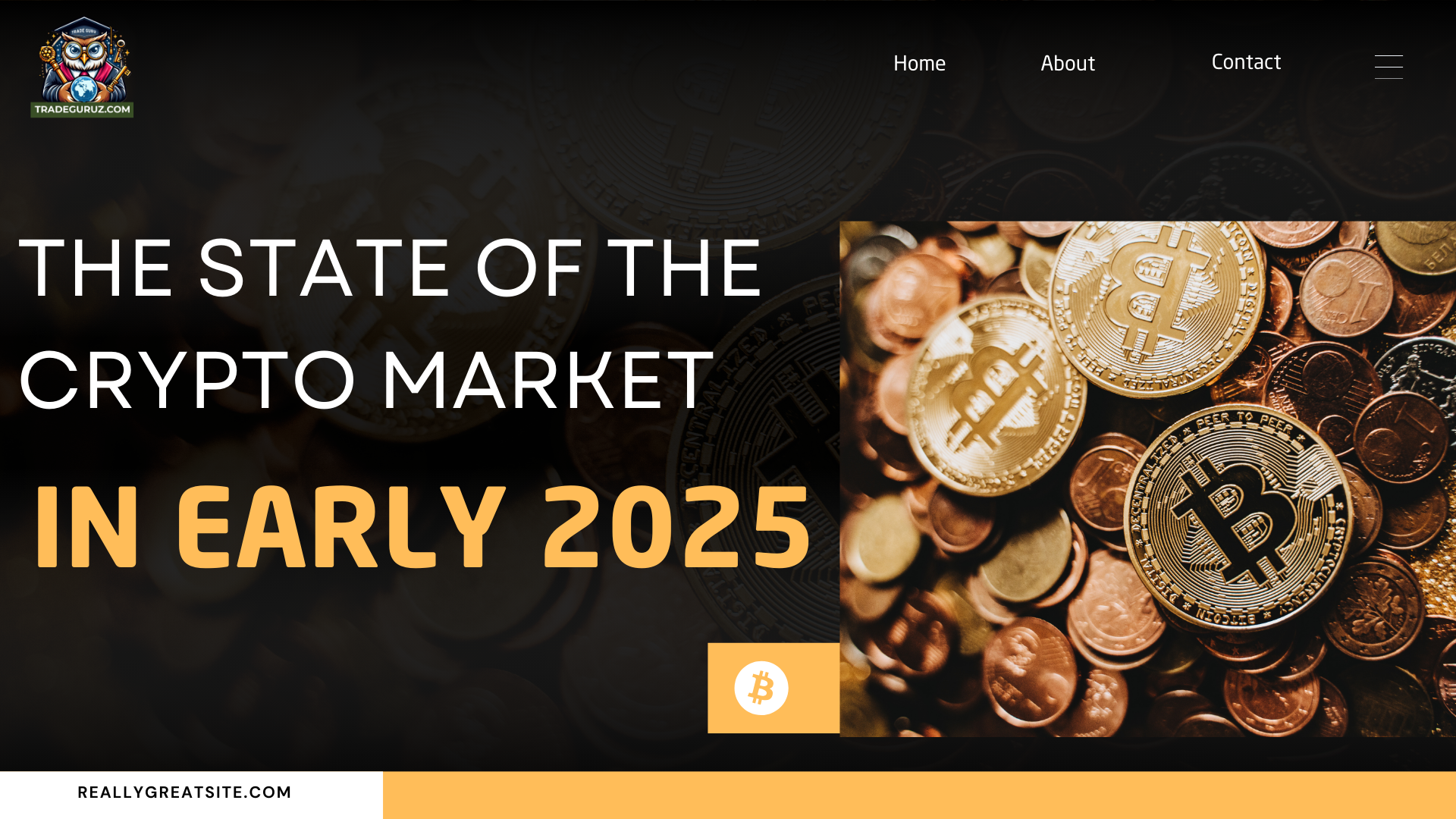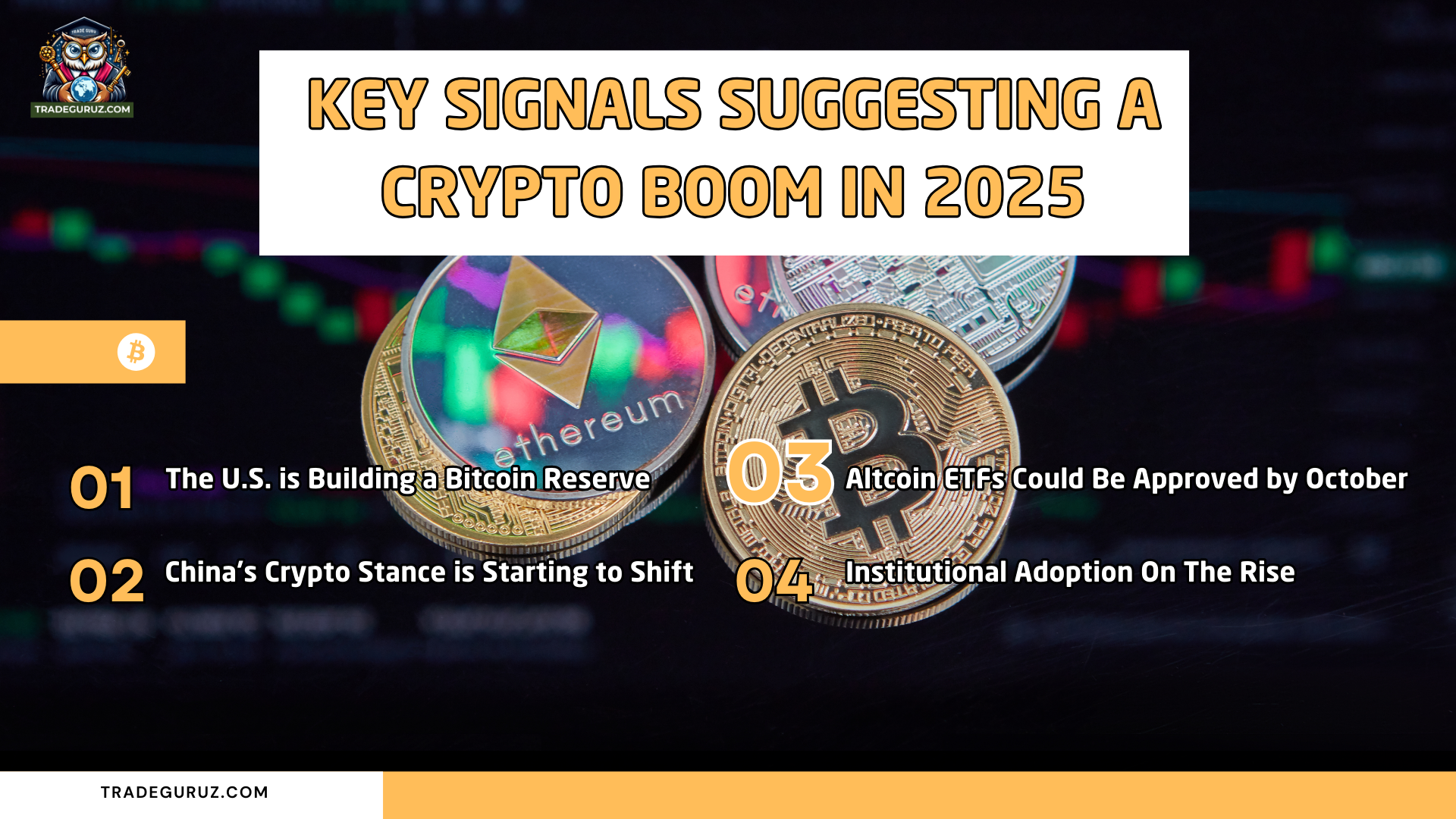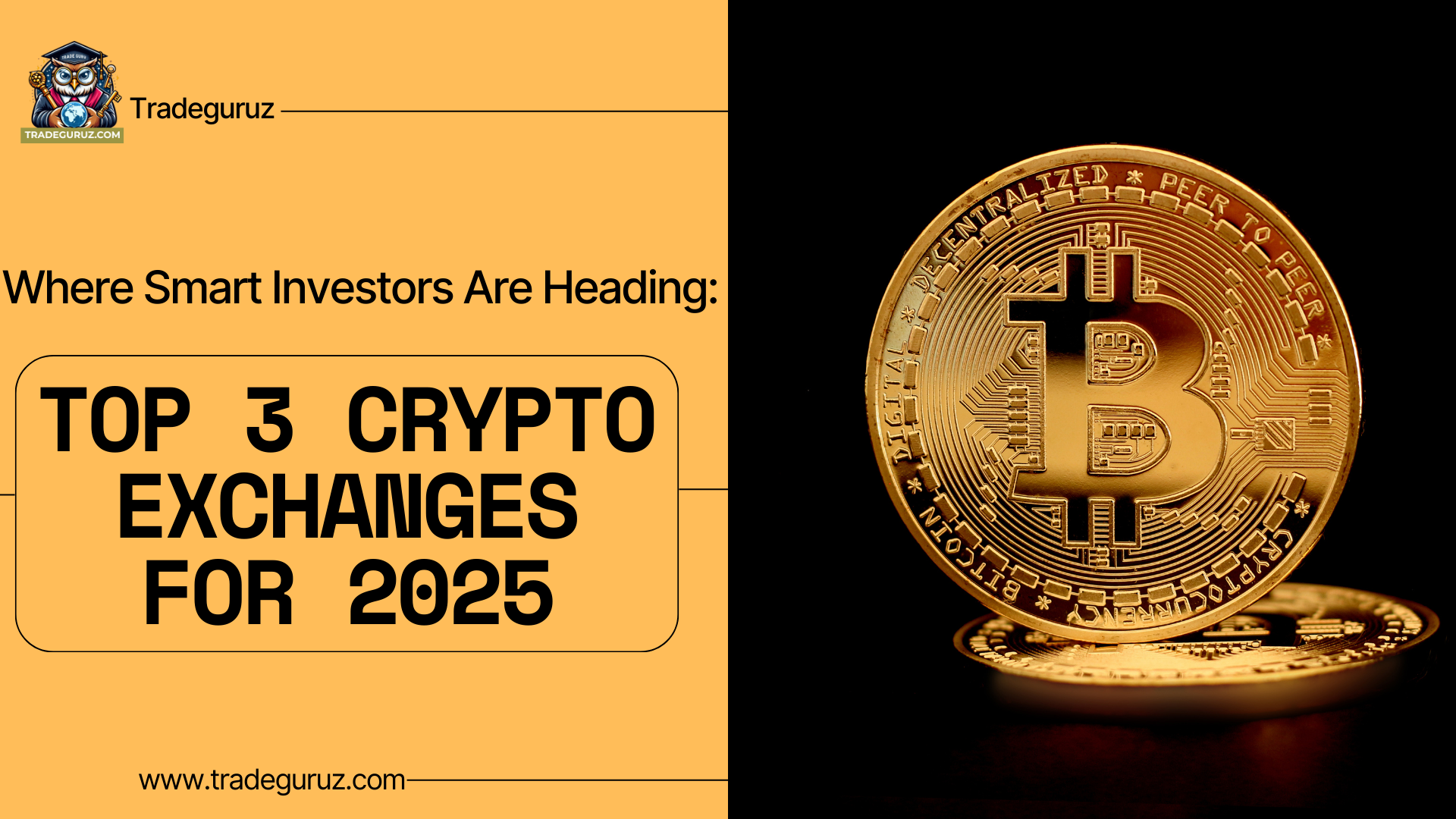



Stepping into 2025, the cryptocurrency market is witnessing various remarkable changes. Following a year of intense volatility in 2024, the crypto landscape is beginning to take shape with greater clarity fueled by a wave of promising signals and renewed investor optimism. The cryptocurrency exchange has become an ideal destination for beginners and experienced investors. Why is that? Let's look at the market context at the beginning of this year and explore the key factors driving the demand for cryptocurrencies to answer this question.
The crypto market is staging a strong comeback in early 2025. One of the key catalysts behind this recovery was Bitcoin’s halving event in April 2024. Historically, Bitcoin tends to gain significant traction within 12 to 18 months after each halving. This time appears to be no exception. The post-halving momentum has started to spark a broad market rally, setting the stage for what many expect to be a breakout year for digital assets. Despite facing pressure from President Trump’s aggressive tariffs impacting the global economy, there is still no shortage of bullish predictions. Some analysts forecast that Bitcoin could hit $200,000 by the end of this year. It is time to affirm that virtual currency is no longer a playground for small investors as before but is entering a professionalization phase.
Another notable point is that investor sentiment has also noticeably changed. After a crisis of confidence sparked by a wave of cryptocurrency exchange collapses and fraud cases in 2022–2023, the optimistic signals of the market have made more investors consider entering this market again. They are no longer only interested in short-term profits but have begun to look for reliable platforms, transparent financial products, and especially legal guarantees. This is why reputable exchanges have gradually become the focal point for global capital flow.
Meanwhile, the macro environment is also favorable for this emerging industry. After a prolonged period of high interest rates aimed at curbing inflation, the U.S. Federal Reserve has begun signaling interest rate cuts in 2025. This has triggered a shift away from bonds and savings toward assets like stocks, gold, and most notably, crypto. Investors are eyeing digital assets as a high-reward opportunity during the recovery cycle. Besides, other optimistic signals show that it is clear that crypto is not just back; it is booming. So, what exactly are the signs pointing to this explosive growth in 2025? Let’s dive into the details in the next section.

One of the strongest signals of crypto adoption came from the United States. On March 6, 2025, President Donald Trump signed an executive order establishing a National Bitcoin Reserve Fund. The Secretary of Commerce was instructed to acquire as much Bitcoin as possible in a "budget-neutral" manner. With the decision to retain 200,000 BTC previously seized as part of national reserves, the U.S. officially recognized Bitcoin as no longer just a speculative asset. It is now being treated as a long-term store of value, similar to gold. The administration also created a dedicated Cryptocurrency Task Force, underscoring that the U.S. government is now taking digital assets seriously. From now on, financial strategies and macro policies will have room for cryptocurrencies.
In addition, this move by the U.S. triggered a domino effect, especially among individual investors. In the past, users often entered the market with a "surfing" mentality or short-term investment. But now, they have started to invest more strategically and behave like professional investors. As a result, traders are becoming more selective about which exchanges they use. Gone are the days when flashy promotions or easy onboarding were enough. Investors now prioritize regulatory clarity, reasonable fees, stable technology, and top-tier security.
China’s crypto ban was arguably one of the catalysts for the 2021 crash. But 2025 is starting to look more optimistic. While the trading ban has yet to be fully lifted, Beijing has shown more openness to blockchain development, piloting a digital yuan, and recently granting permission for several digital asset-related ETFs to operate indirectly in Hong Kong. This indicates that China is gradually shifting from confrontation to wise control, encouraging innovation while keeping a tight lid on systemic risk. Various sources also believe China is actively considering policy changes related to Bitcoin and cryptocurrencies. Given China’s enormous influence in global financial markets, any positive signals from the billion-people nation could create a strong wave of investment.

After the official spot Bitcoin ETFs are approved and operational, other altcoin ETFs are also being submitted to the SEC. October 2025 is the deadline for the SEC to approve XRP, Solana, Cardano, Dogecoin, and Polkadot ETFs. According to numerous experts, there is a strong likelihood these ETFs will get the green light, opening the door for hundreds of billions of dollars from institutional investors to pour into the altcoin market. Beyond the capital inflow, listing altcoins on regulated stock exchanges via ETFs would drastically boost their liquidity and market capitalization. Instead of being confined to decentralized environments, these assets could now access transparent, large-scale funding from traditional markets, providing both price momentum and long-term stability.
Most importantly, the altcoins' presence in regulated financial products such as ETFs will help legitimize and professionalize the crypto market. Only projects that qualify for ETF consideration must meet strict standards regarding technology, transparency, and growth potential. As a result, the market grows in size and filters out low-quality projects. In other words, if spot Bitcoin ETFs were crypto’s entry ticket into mainstream finance, then altcoin ETFs will be the next step in legitimizing and expanding this space comprehensively and sustainably.
This year, the cryptocurrency market is expected to attract massive capital flows from financial institutions and professional investors worldwide. According to the latest report from Coinbase and EY-Parthenon, over 83% of institutional investors surveyed said they plan to increase their crypto allocations this year. Remarkably, 59% of them expect to dedicate more than 5% of their total assets under management (AUM) to crypto or related products, a clear shift in institutional portfolio strategies.
Despite their initial skepticism and reservations, by 2025, the attitude of banks and hedge funds towards cryptocurrencies has changed dramatically. An increasing number of traditional financial institutions have set up dedicated crypto trading desks, rolled out digital asset custody services, and even begun piloting blockchain-based projects. Some larger firms are now exploring tokenized assets, such as tokenized bonds and fractionalized real estate. This demonstrates that cryptocurrencies are no longer just a speculative instrument but are gradually transforming into a diverse, deep, and more closely integrated market with traditional finance.
Beyond the external tailwinds pushing the crypto market forward, exchanges are making comprehensive efforts to evolve into secure, investment-worthy platforms for a global user base. In 2025, concerns about safety and security are gradually being addressed, reducing one of the main perceived risks of investing in crypto.

As the global regulatory landscape tightens, compliance is no longer optional, it is a matter of survival. Exchanges must comply with the laws of multiple jurisdictions to avoid penalties and remain in business. Major platforms are racing to secure licenses in key regions, establishing dedicated legal departments, partnering with regulators, and implementing stricter KYC (Know Your Customer) and AML (Anti-Money Laundering) protocols than ever before. Compliance allows exchanges to avoid the risk of being banned and opens the door to institutional capital, investors who only trust systems with clear legal frameworks.
In response to regulatory demands, exchanges have turned to cutting-edge technology to improve compliance and user protection. Artificial intelligence has been deployed to monitor transactions and detect suspicious activity in real time. These tools not only help meet regulatory requirements but also improve the user experience. On the security front, exchanges are adopting biometric authentication methods, such as fingerprints and facial recognition, to enhance the security of user accounts. Additionally, cross-chain interoperability enables seamless transactions between multiple platforms, expanding accessibility and flexibility for users.
Recognizing the importance of international alignment, crypto exchanges are increasingly engaging in global standardization efforts. They have collaborated with regulatory bodies and international organizations to create a unified framework that promotes both compliance and investor protection worldwide. This cooperation minimizes regulatory risks and promotes the sustainable development of the cryptocurrency market.
Exchanges are actively working to educate users and build greater awareness around cryptocurrencies and blockchain technology. They offer learning resources, online webinars, and market analysis tools to support more informed and responsible investment decisions. For instance, Coinbase delivers learning tools to help users understand the basics of cryptocurrencies and blockchain technology. In addition, exchanges are actively publishing articles on the importance of KYC/AML and building community forums where users can discuss regulatory issues.
While 2025 may be a volatile year for the global economy, it is shaping up to be a golden opportunity for crypto. If not now, then when? Here are the top three crypto exchanges worth considering for investment this year.

2025 marks a breakthrough year for Bybit, as the exchange surpasses 60 million users worldwide, with a daily average trading volume of $36 billion. Bybit has driven its success by building a smooth, high-speed trading platform and strategically expanding its ecosystem across Web3, DeFi, and staking. Typically, Bybit launched bbSOL, the first liquidity staking token supported on Solana - quickly reaching a TVL of more than 240 million USD in just 5 months. Bybit also demonstrates its long-term vision through its 2025 operating philosophy: "Listen - Care - Improve", focusing on user experience and committing to offering increasingly optimal trading tools, liquidity, and products. This cryptocurrency exchange has initiated a partnership with the Nordic Blockchain Association to promote innovation in the Web3 sector in the region, demonstrating its sustainable and in-depth development orientation.
How to Create a Bybit Account: Simple Guide for Beginners
KuCoin continues to affirm its position as one of the most popular crypto exchanges in the world, with over 40 million users in over 200 countries and territories. Known as the “People’s Exchange” thanks to its user-friendly interface and vast selection of over 900 coins, KuCoin is gradually restructuring to meet increasingly stringent regulatory demands in 2025. Following legal challenges in the U.S. in 2023, KuCoin has stepped up its KYC and AML compliance while enhancing internal security protocols. The exchange has implemented a Proof of Reserve program, disclosing asset holdings to improve transparency and rebuild user trust. KuCoin continues to develop the Earn, lending, and futures segments while increasing support for Web3 and GameFi projects. While it may not yet lead in compliance, KuCoin is seriously trying to align its strategy with a global crypto landscape.
How to Create a KuCoin Account: Easy Steps for New Users
Bitget is proud to be the second largest cryptocurrency exchange ecosystem in user base, with over 100 million global users. It is taking steady steps in the legal field. This platform operates according to international standards and is licensed by major regulatory agencies in the United States, Canada, and Singapore. A standout feature of Bitget is its $496 million user protection fund, offering a critical safety net against potential losses from system failures or cyberattacks. With a commitment to transparency, user support, and security, Bitget is becoming a trusted hub for newbies and seasoned investors.
How to Create a Bitget Account: Step by Step Registration Guide
The crypto market in early 2025 is not just experiencing a rebound, it is entering a new era of sustainable growth driven by a convergence of powerful forces: renewed investor confidence, institutional adoption, and continuous advancements in core technologies. This transformation is also reshaping how people view the cryptocurrency exchange, now seen not merely as a trading platform but as a central gateway to the future of finance. With everything currently unfolding, one thing is clear: Crypto is back and stronger than ever.
Thank you for spending your time reading this entire article.
For more information, please contact us at TRADEGURUZ.